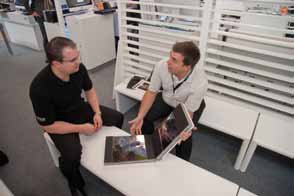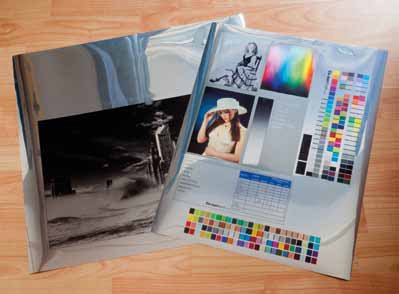articles/Paper/metalicprooftransfer-page2
Specialist Papers - Permajet Digital Transfer Film - Epson MetallicProof - part 2 of 1 2 3
by Mike McNamee Published 01/04/2012

Epson MetallicProof
This media was developed so that carton and packaging designers could proof their concepts when the intended output was onto a metallised foil or card. However, it has not taken long for the experimentalists to think of ways of using it creatively. We were introduced to this at Focus when shown the work of John Fox of Gem Photography who has a complete wedding album made from MetallicProof. The pages were laminated and then bound in the usual way.
Testing
The media is available in roll form only and was tested on our Epson 4900 with Matt Black ink. The profile used was that for DisplayTrans Backlight media (SP7900 9900 DTBLM Mk v2.icc for the record). We are unsure how the profile was made, our own spectro would not look at the test targets, the reflective surface simply confused it! Single readings were possible but even these were compromised as a patch that looked correct by visual assessment was some 20 to 30% too dark as read by the spectro. Overall then no form of analysis could be carried out - it was all down to our eyes.
Visually the prints were a little yellow, the shadows separated down to 30RGB points and the highlights faded away beyond 240 RGB points. On this basis some experimentation would be needed to 'correct' the image for an improved look. It might also be that we were using the profile from a slightly different machine (but as explained we could not make a profile).

The impact of the prints cannot be reproduced on a magazine page or indeed even photographed! The highlights reflect back the surroundings if you focus your eyes beyond the surface, it is after all a mirror finish. As an album media it would make a striking cover or section spacer or perhaps a wall portrait - we are to be convinced that an entire album does not look slightly over the top, but that is a matter of taste.
Technically there are a few issues to watch for. The ink surface is very soft before it dries and remains vulnerable afterwards. One print fell out onto the office carpet while still wet, it was not a pretty sight! Also during printing you have to keep the surroundings clean and dust free and the media covers shut. The vast expanse of plastic generates a large static electricity charge which seems to suck stuff out of the air; operators with dry skin or dandruff will have to be particularly vigilant and stay well away from exposed areas of the media. Once the print has dried, cold lamination is essential, something that you may already have built in to your album workflow. The Hotpress kit seems to do the job OK.
Overall then, MetallicProof offers possibilities for something radically different. As we have said, full albums might be a little OTT but just a cover to an album on your studio coffee table would certainly attract attention. Selling a wall portrait might be an easier proposition.
Please Note:
There is more than one page for this Article.
You are currently on page 2
- Specialist Papers - Permajet Digital Transfer Film - Epson MetallicProof page 1
- Specialist Papers - Permajet Digital Transfer Film - Epson MetallicProof page 2
- Specialist Papers - Permajet Digital Transfer Film - Epson MetallicProof page 3
1st Published 01/04/2012
last update 09/12/2022 14:56:42
More Paper Articles
There are 27 days to get ready for The Society of Photographers Convention and Trade Show at The Novotel London West, Hammersmith ...
which starts on Wednesday 14th January 2026





